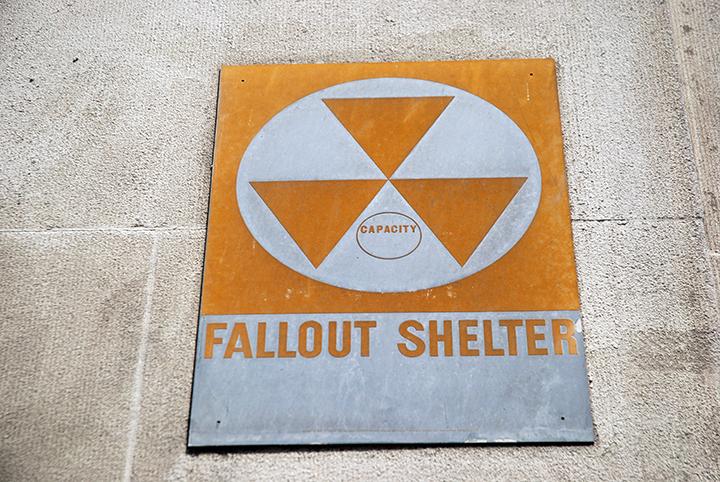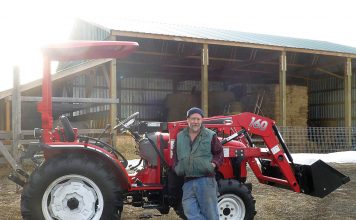 |
|
| Issue #74 • March/April, 2002 |
Are you prepared for a disaster that could affect the daily function of your life or the lives of your family members? Or do you even believe a disaster will ever affect you?
Earthquakes, blizzards, hurricanes, electrical power outages, and who knows what else happen all the time. Still, most Americans ignore the warnings. “It can’t happen here,” some say. “The government will take care of me if it does,” others think.
But not only do they happen, they can happen to you. And when they do, you will be on your own. The tragedy of September 11 illustrates this well. Look at the total disruption of transportation and emergency services in New York City immediately following the terrorist attack. This was followed by the immediate and complete paralysis of air transportation throughout the United States. Thousands were stranded for days on their own in strange cities.
Anthrax attacks followed, paralyzing the mail service and spreading terror across the nation. Hazardous materials teams and health departments throughout the nation were swamped with false calls from citizens fearing anthrax-laced letters.
|
As serious as these attacks were, they pale in comparison to the possibilities. Consider a major biological or nuclear attack or accident. Hundreds of thousands of casualties are predicted in some scenarios. Even the major earthquake predicted for the Midwest is expected to cause widespread destruction and casualties.
These disasters or attacks would overwhelm local, regional, and national emergency resources and cause widespread panic. Transportation would stop, markets would be stripped of food within hours, essential emergency services would be overwhelmed, and food, medical supplies, and emergency service workers would be sent to the disaster area, leaving critical shortages in local areas. After Hurricane Andrew devastated Florida, plywood was in short supply throughout the country as it was being sent to rebuild the state.
Many do not prepare for these emergencies. During one earthquake in southern California, people were lined up outside hospitals to get Band-aids. They were so unprepared that they did not even have basic first aid kits, overwhelming medical personnel who were trying to deal with the severely injured.
Are you prepared?
Now, more than ever, you need to prepare for the possibility of disasters or attacks on a scale and type never before imagined. It is your duty to yourself, your family, and your country to be prepared.
Some of us need to be prepared for being at “ground zero.” Certain areas are the most likely direct targets of terrorists or natural disasters. All of us need to be prepared to be indirect targets, those affected by the temporary collapse of our nation’s infrastructure.
In short, we all need to be able to live self-sufficiently for a period of time.
What to prepare for will depend on your geographical area. Natural disasters and the risk of major terrorist attacks vary by where you live. The first thing you need to do is make a list of the possible disasters for which you need to prepare. Some of the things you will want to consider include natural disasters, such as blizzards, floods, earthquakes, hurricanes, and wild fires, as well as technological disasters, such as nuclear, biological, chemical (NBC) attacks, and hazardous material accidents.
Don’t forget cyber-attacks, the possibility that an enemy could attack our computer systems, shutting down electrical, gas, communications, transportation, and emergency and medical services. What about attacks on our farms and agricultural processing plants? While they would likely affect only a small number of people directly, they would completely shut down food production and distribution systems.
While there are many things to plan for, your response to all of them is one of two things: stay at home or evacuate. For blizzards, earthquakes, cyber-attacks, nuclear fallout, quarantine after biological attacks, and collapse of the infrastructure, you will want to stay at home. For floods, hurricanes, or with some advance notice of NBC attacks, evacuation may be your course of action.
Whenever possible, staying at home in your own environment and with your own emergency supplies is the best choice. When you evacuate, you are essentially a refugee at the mercy of government evacuation centers or the compassion of the local population. In a major disaster, don’t expect to be welcomed by the locals who are struggling with their own survival.
In all situations, you will need to be able to think for yourself. Confusion always accompanies a major disaster and initial information and instructions may be conflicting and incorrect. Some caught in the World Trade Center were initially advised that everything was fine and they should stay at their desks. Those who took matters into their own hands immediately evacuated the building. So, monitor the radio and television for official instructions on what to do, such as whether to evacuate or not, but don’t assume they are correct. Make your own decisions based on your plans and preparation.
Riding it out at home
Key to your survival is preparing a disaster supplies kit, essentially the stockpiling of all materials that you would need to live on if you are cut off from outside utilities, water, and supplies. Once a disaster occurs, there won’t be time and materials may not be available.
How long you will need to be self-sufficient is hard to say. The Federal Emergency Management Agency (FEMA) advises everyone to store enough food, water, and supplies to take care of their family for three days. Preparing a “72-hour kit” is a good idea. It can be used for immediate evacuation and part of your overall disaster supply kit. Place items in a portable, easy-to-carry container, such as a large plastic box or duffel bag, ready to grab at a moment’s notice.
But, is it enough? A blizzard, earthquake, quarantine, or nuclear fallout could confine you for much longer. You need to be able to take care of all the needs for your family for a period of at least two weeks and possibly longer. Having supplies for one to three months is not all that unreasonable or hard to accomplish.
There are six basics that should be part of your home disaster supplies kit: water, food, first aid supplies, tools and emergency supplies, clothing and bedding, and special needs items.
Water An individual must drink at least two quarts of water per day to avoid dehydration, and as much as four to five in hot weather or if they are exercising or working hard. Store at least a gallon of water per person per day (two quarts for drinking and two for food preparation and sanitation) in food-grade plastic containers, such as water containers or empty two-liter soda bottles. Thirty to fifty-gallon containers are also available and can be stored in a garage or shed. Rotate water supplies every six months so they stay fresh.
For extended disasters, additional water may need to be obtained. Rain is pure water and can be used without further purification. Water from lakes, streams, or reservoirs should be purified by boiling, using a portable water filter, or by adding a water purification chemical, such as Polar Pure or Potable Aqua.
|
Food Non-perishable foods that require no refrigeration or cooking and which use little or no water to prepare are the best for your disaster kit. Ready-to-eat canned foods including meats, stews, beans, fruits, and vegetables are the mainstay of the food supply, along with canned juices, milk, and soups. Include high energy foods, such as peanut butter, crackers, granola bars, energy bars, or trail mix and some comfort foods, such as cookies, hard candy, coffee, or tea.
For foods that must be cooked, be sure to have a camping-type cook stove and fuel, Dutch oven and briquettes, or other cooking source. This will allow you to prepare more types of food, such as rice, dehydrated foods, flour biscuits, and cornbread.
Consider shelf life of stored foods. Rotate regular canned goods and food every six months. Eat the stored food as part of your regular meals, replacing it with newly purchased food. (Read Backwoods Home Magazine’s Emergency Preparedness and Survival Guide advertised on page 19 of this issue.)
Numerous companies sell emergency foods that are packaged to last for 5 to 10 years and are good to have around since you don’t have to worry about rotating food as often. Military MREs (Meals Ready To Eat) are also available and have a long shelf-life, although they are bulky and expensive. They are convenient to have in your vehicle disaster kit, however.
First aid supplies First aid kits should be available in your house and vehicles. Your local American Red Cross chapter can supply you with a basic first aid manual and list of first aid supplies. Your home kit should include items to treat injuries such as lacerations, sprains, and burns, as well as medicines, such as aspirin or non-aspirin pain relievers, anti-diarrhea medicine, laxatives, and antacids.
Tools and emergency supplies Tools and emergency supplies should include such things as battery-operated radio and flashlights with extra batteries, cups/plates/utensils, non-electric can opener, matches, lantern, fire extinguisher, hand tools for repairs and to turn off household water and gas, a whistle, and plastic sheeting. For sanitation, include toilet paper, towelettes, soap, toothpaste, personal hygiene items, disinfectant, and household chlorine bleach. Many more items can be added. Think through the things you use on a daily basis.
Clothing and bedding Clothing and bedding would include a change of clothing and footwear for everyone in the household, rain gear, cold weather clothes, hat and gloves, and blankets or sleeping bags. Remember, a house or car can get very cold without heat. Prepare for the worst weather that you might encounter.
Special needs items Special needs items may include formula and diapers for infants, prescription medications, contact lenses and supplies, extra glasses, and other supplies or equipment for infant, elderly, or disabled individuals. Ample pet food should also be stored. Confinement in the house during a disaster can be boring, especially for children, so remember books, games, and other entertainment.
Store your disaster supply kit in a convenient place that is known to all family members and make sure they know your family’s disaster plan. Evaluate your kit once a year and update it according to family needs.
Evacuation
You may not have much time to prepare when you need to evacuate. A hazardous materials spill could mean instant evacuation, so always have a smaller version of your home disaster supply kit in the trunk of your car.
When you have advance warning of an evacuation, bring your portable “72-hour” disaster supply kit, along with additional food, water, and clothing. Keep important family documents in a waterproof, portable container, ready to bring with you in an evacuation. These may include your will, insurance policies, contracts, deeds, stocks and bonds, passports, social security card, bank and credit account numbers, family documents (birth, marriage, and death certificates), inventory of valuable household items, and important telephone numbers. It would be a good idea to always keep some cash in this container, so you have it for an emergency. If there is time, valuable family heirlooms or photographs can be added.
Keeping a checklist of what to bring in an evacuation is a good idea. In the stress of the moment, it is easy to forget an important item.
Now that you have a basic plan for any emergency, let’s consider plans for some specific risks.
Nuclear attack/accident
A nuclear disaster could result from an accident at a nuclear power plant, a detonation of a nuclear device by terrorists or a rogue nation, or an explosion of a “dirty” bomb, an explosive surrounded by radioactive material. Individuals at “ground zero” will have little chance of survival. The risk for others is the exposure to radiation.
Radiation is dangerous because of harmful effects on the body. In large amounts, radiation can cause radiation sickness, thyroid and other cancers, and death. These effects are greater the longer a person is exposed to the radiation and the closer the person is to the source. If radiation is released into the atmosphere, it can travel for thousands of miles, contaminating the ground and living organisms as it settles back to earth on dust or rain. This is called fallout radiation.
Time, distance, and shielding are the factors that minimize exposure to nuclear radiation. Most radiation loses its strength fairly rapidly, but it is important to limit the amount of time spent near the radiation source. The farther away an individual is from the radiation source, the less exposure. Shielding is a barrier between an individual and the radiation. Concrete, earth, and structures are good shields. Depending on the distance from the source, the best protection from radiation fallout may be to remain indoors.
After a nuclear disaster you may be advised to evacuate. If so, remain calm, pack your evacuation survival kit in your vehicle, and follow the evacuation routes out of the area. If there is time before leaving, close and lock windows of your house, close fireplace dampers, turn off air conditioning, vents, fans, and furnace. Doing these things will make your house safer when you return by minimizing exposure to the inside of your house to fallout.
If you are advised to remain at home, bring pets inside, secure your house from fallout by closing and locking doors and windows, closing fireplace dampers, turning off air conditioning, vents, fan, and the furnace. If your emergency supplies are stored in a garage or barn, bring them inside and, if there is time, store additional water in tubs, sinks, and available containers. Inside the house, the safest area is a basement or underground area, followed by an interior room with no windows. Stay inside until authorities say it is safe to go outside.
When coming in from the outdoors after exposure to fallout, shower and change clothes and shoes. Put the contaminated items that were worn outside in a plastic bag and seal it. Open water sources (streams, creeks, lakes), fruits and vegetables from outdoor gardens, and livestock will all be contaminated. Do not eat or drink products from these until you know it is safe.
(Also read Jeff Yago’s article in this issue about building an underground shelter, and John Silveira’s article on terrorists and nuclear devices.)
Bioterrorism
Very few people were actually infected in the anthrax attacks because it took direct physical contact with the bacteria to develop the disease. Other biological agents are contagious (passed from person to person), however, and are much more dangerous.
|
Biological agents are microorganisms (bacteria or viruses) or toxins that produce diseases in humans. The Center For Disease Control (CDC) lists 17 biological agents that may be used as weapons, including anthrax, smallpox, plague, and botulism. They are not immediately detectable, may take days to grow and spread, and it is impossible to know when an attack occurs. While preparations are being made for defense against such attacks, nobody really knows what to expect. Fortunately, most of these biological agents are hard to make into weapons. Worst-case scenarios, such as suicide terrorists infected with smallpox traveling through metropolitan areas, are staggering, however. Thousands of victims would overwhelm medical services and die.
Likely? Hopefully not, but who knows? Those at “ground zero” who are infected will need professional medical help. With air travel, people will spread the disease all over the country before we even know an attack occurred. The rest of the country will shut down as soon as authorities realize what happened.
Expect widespread closure of the country and mandatory quarantines. Transportation, food, and vital services will stop. Plan to stay at home if advised or ordered and avoid exposure with outsiders who may carry disease. Your stockpile of food and supplies should get you through this disaster. You may want to have some medical-type masks and gloves on hand.
Should you stockpile antibiotics in preparation for such attacks? Authorities say no and this may be practical advice. A large number of different types and amounts of antibiotics would need to be stored to protect your family against all likely biological weapons. Many of the diseases are viruses, not treatable with antibiotics, and those treatable by antibiotics might be altered to make them resistant to available antibiotics. Besides, you will need professional medical care if you are exposed.
Chemical terrorism and hazardous spills
Chemical agents are gases, liquids, or solids that are poisonous to humans. Depending on the type and amount of the material, exposure to chemical agents can cause illness or be fatal. Chemical agents include chlorine or ammonia gases that are transported on trains daily, other hazardous industrial chemicals, and chemical warfare agents, such as nerve agents, blister agents, blood poisons, and others. The CDC lists 58 known chemical warfare agents.
Some nerve agents, such as Sarin, used in the attack in Japan, kill quickly. If you are at “ground zero” in such situations your only chance is to evacuate immediately.
A hazardous materials spill is probably more likely than a terrorist chemical attack. For gases and other chemicals that spread in the air, evacuation to avoid exposure is critical. Leave the area as soon as you are aware of the incident. Full face respirators (gas masks) may be useful for escape in such situations. Buy good quality, new masks designed for industrial or rescue use, not army surplus masks. New respirators cost about $80 and are not a bad idea to have, especially if you live in the vicinity of train tracks where derailment of cars containing chorine or ammonia is a possibility.
Natural disasters
Natural disasters are somewhat easier to prepare foryou either get out of their way (evacuate) or you protect yourself indoors.
Floods Sandbag doors and windows, move furniture and other items to higher ground, and evacuate if necessary. Do not drive or walk through flood waters and stay off bridges when they are covered with water.
Hurricanes Preparation should include boarding up windows and flood-proofing your home. Bring in outside furniture, bicycles, and garbage cans. Listen to recommendations of emergency officials and evacuate if advised. If not advised to evacuate, stay indoors and away from windows.
Blizzards Stay indoors and use the telephone only for life-threatening emergencies. Use fires safely and properly ventilate. It there is no heat, cover windows, close off un-needed rooms, and stuff towels in cracks under doors. Wear layers of warm clothing. Eat and drink plenty. Food generates body heat and water helps circulation to keep the skin warm.
Earthquakes If you are indoors, stay there and take cover under a heavy table or desk while keeping away from windows. Do not use elevators. If you are outdoors, stay outdoors and watch for falling debris, trees, or power lines. After the earthquake, check for injuries or fires, check for damage including gas, water, and electrical lines. If you smell gas or there is a fire, turn off the gas at the main gas valve and switch off the main circuit breaker. Do not enter damaged buildings.
Be prepared
It is important to know what to do and have a plan before a disaster strikes. The American Red Cross and FEMA can provide additional information for preparing for and dealing with natural disasters and terrorist attacks. Consider your risks, develop a plan, prepare your disaster supplies kit, and discuss with your family what to do in case of an emergency.
Remember, the future belongs to those who prepare. You must be ready before disaster strikes.
Sources
Two of the best sources of information to help you prepare are the Backwoods Home Magazine Emergency Preparedness and Survival Guide and their Years 7-10 CD-ROM, both of which are advertised on the next page. The Emergency Preparedness and Survival Guide is a quick, concise paperback read100 pages (its companion CD-ROM has several hundred pages). The Years 7-10 CD-ROM is a big in-depth read1497 pages.

















